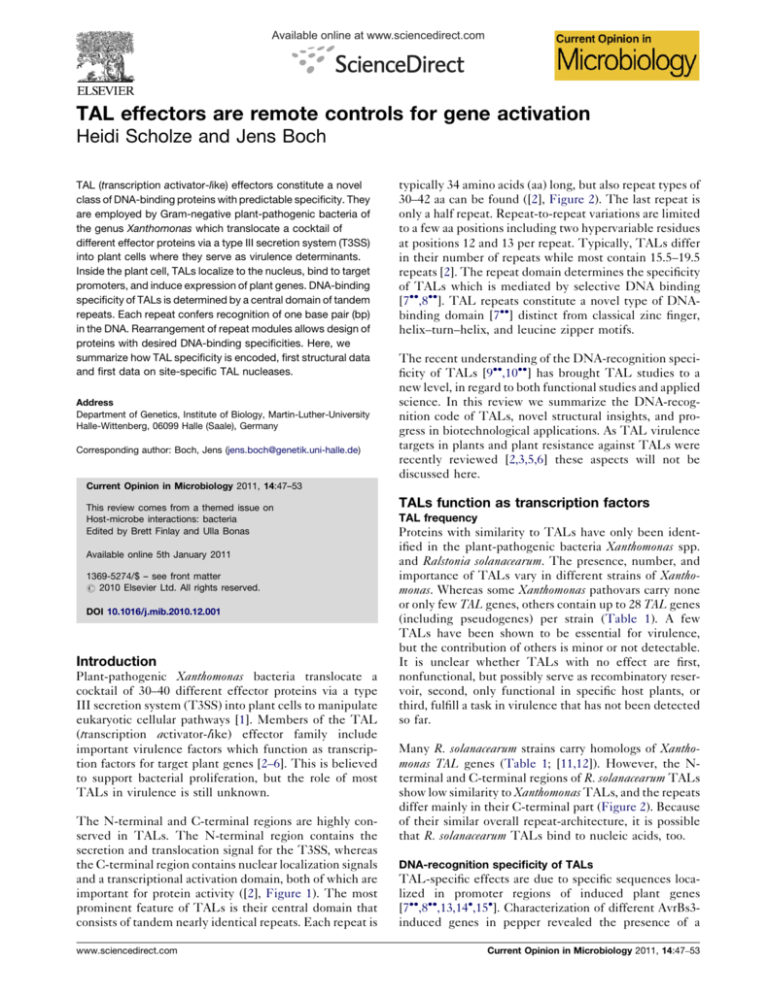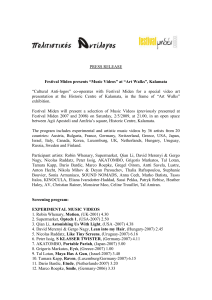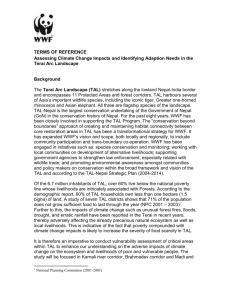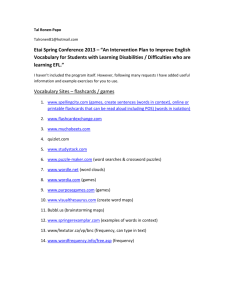
Available online at www.sciencedirect.com
TAL effectors are remote controls for gene activation
Heidi Scholze and Jens Boch
TAL (transcription activator-like) effectors constitute a novel
class of DNA-binding proteins with predictable specificity. They
are employed by Gram-negative plant-pathogenic bacteria of
the genus Xanthomonas which translocate a cocktail of
different effector proteins via a type III secretion system (T3SS)
into plant cells where they serve as virulence determinants.
Inside the plant cell, TALs localize to the nucleus, bind to target
promoters, and induce expression of plant genes. DNA-binding
specificity of TALs is determined by a central domain of tandem
repeats. Each repeat confers recognition of one base pair (bp)
in the DNA. Rearrangement of repeat modules allows design of
proteins with desired DNA-binding specificities. Here, we
summarize how TAL specificity is encoded, first structural data
and first data on site-specific TAL nucleases.
Address
Department of Genetics, Institute of Biology, Martin-Luther-University
Halle-Wittenberg, 06099 Halle (Saale), Germany
Corresponding author: Boch, Jens (jens.boch@genetik.uni-halle.de)
typically 34 amino acids (aa) long, but also repeat types of
30–42 aa can be found ([2], Figure 2). The last repeat is
only a half repeat. Repeat-to-repeat variations are limited
to a few aa positions including two hypervariable residues
at positions 12 and 13 per repeat. Typically, TALs differ
in their number of repeats while most contain 15.5–19.5
repeats [2]. The repeat domain determines the specificity
of TALs which is mediated by selective DNA binding
[7,8]. TAL repeats constitute a novel type of DNAbinding domain [7] distinct from classical zinc finger,
helix–turn–helix, and leucine zipper motifs.
The recent understanding of the DNA-recognition specificity of TALs [9,10] has brought TAL studies to a
new level, in regard to both functional studies and applied
science. In this review we summarize the DNA-recognition code of TALs, novel structural insights, and progress in biotechnological applications. As TAL virulence
targets in plants and plant resistance against TALs were
recently reviewed [2,3,5,6] these aspects will not be
discussed here.
Current Opinion in Microbiology 2011, 14:47–53
This review comes from a themed issue on
Host-microbe interactions: bacteria
Edited by Brett Finlay and Ulla Bonas
Available online 5th January 2011
1369-5274/$ – see front matter
# 2010 Elsevier Ltd. All rights reserved.
DOI 10.1016/j.mib.2010.12.001
Introduction
Plant-pathogenic Xanthomonas bacteria translocate a
cocktail of 30–40 different effector proteins via a type
III secretion system (T3SS) into plant cells to manipulate
eukaryotic cellular pathways [1]. Members of the TAL
(transcription activator-like) effector family include
important virulence factors which function as transcription factors for target plant genes [2–6]. This is believed
to support bacterial proliferation, but the role of most
TALs in virulence is still unknown.
The N-terminal and C-terminal regions are highly conserved in TALs. The N-terminal region contains the
secretion and translocation signal for the T3SS, whereas
the C-terminal region contains nuclear localization signals
and a transcriptional activation domain, both of which are
important for protein activity ([2], Figure 1). The most
prominent feature of TALs is their central domain that
consists of tandem nearly identical repeats. Each repeat is
www.sciencedirect.com
TALs function as transcription factors
TAL frequency
Proteins with similarity to TALs have only been identified in the plant-pathogenic bacteria Xanthomonas spp.
and Ralstonia solanacearum. The presence, number, and
importance of TALs vary in different strains of Xanthomonas. Whereas some Xanthomonas pathovars carry none
or only few TAL genes, others contain up to 28 TAL genes
(including pseudogenes) per strain (Table 1). A few
TALs have been shown to be essential for virulence,
but the contribution of others is minor or not detectable.
It is unclear whether TALs with no effect are first,
nonfunctional, but possibly serve as recombinatory reservoir, second, only functional in specific host plants, or
third, fulfill a task in virulence that has not been detected
so far.
Many R. solanacearum strains carry homologs of Xanthomonas TAL genes (Table 1; [11,12]). However, the Nterminal and C-terminal regions of R. solanacearum TALs
show low similarity to Xanthomonas TALs, and the repeats
differ mainly in their C-terminal part (Figure 2). Because
of their similar overall repeat-architecture, it is possible
that R. solanacearum TALs bind to nucleic acids, too.
DNA-recognition specificity of TALs
TAL-specific effects are due to specific sequences localized in promoter regions of induced plant genes
[7,8,13,14,15]. Characterization of different AvrBs3induced genes in pepper revealed the presence of a
Current Opinion in Microbiology 2011, 14:47–53
48 Host-microbe interactions: bacteria
Figure 1
(a)
Repeat domain
0
NLS AD
N
C
T
12/13
34
1
LTPEQVVAIASHDGGKQALETVQRLLPVLCQAHG
(b)
Repeat type
NI HD NG IG NK NN NS
DNA specificity A
C
T
T
G
G
A
A
C
G
T
Current Opinion in Microbiology
TAL effector-DNA-binding code. (a) TALs contain nuclear localization signals (NLS, yellow) and an activation domain (AD, green) to function as
transcriptional activators. A central tandem repeat domain (red) confers DNA-binding specificity. Each 34 amino acid (aa)-repeat binds to one base pair
(bp) with specificity being determined by aa 12 and 13. One sample repeat is shown. Numbers refer to aa positions within the repeat. Repeat zero is
indicated which specifies for T. (b) Repeat types have specificity for one or several DNA bp. Only bases of the DNA leading strand are shown.
common promoter element, termed UPA (upregulated by
AvrBs3) box [7,8,16], which was essential for AvrBs3
recognition and whose function was sensitive to mutations
[7,8,17,18].
The length of the UPA box roughly matches the number
of repeats in AvrBs3, leading to a model to explain
AvrBs3 DNA-recognition specificity [9,10]. Accordingly, one TAL repeat binds to one DNA base pair (bp),
and the specificity of individual repeats is encoded in
the hypervariable residues at positions 12 and 13 in each
repeat (Figure 2; [9,10]; also termed RVD, repeatvariable diresidue). Some repeat types are specific for a
particular DNA bp whereas others recognize more than
one bp ([9,10]; Figure 1). Repeat positions other than
the hypervariable residues do not exhibit a significant
effect on repeat specificity [19]. The target DNA
elements of TALs have been termed differently, that
is, UPA box [7], UPT box (upregulated by TAL, [20])
or simply TAL box [9]. We have suggested to name
this element TAL box (e.g. AvrBs3 box, Hax3 box;
[9]), because the DNA sequence controls recognition
and binding of the TAL, but not necessarily upregulation of gene expression. TAL boxes all start with a ‘T’
indicating that the N-terminal region preceding the first
repeat (termed repeat ‘zero’) contributes to DNA binding ([9,21]; Figure 2). Furthermore, it was shown on
the basis of artificial TALs containing 1.5–16.5 repeats
that a minimum of 6.5 repeats is necessary to induce
transcription and 10.5 repeats are sufficient for full
induction [9].
The simple and modular way of how TALs bind to DNA
has far-reaching consequences. DNA-binding specificities of TALs can be predicted and repeat modules can be
Current Opinion in Microbiology 2011, 14:47–53
rearranged to generate artificial TALs with novel and
predictable DNA-binding specificities [9,22].
TAL repeat structure
PSIPRED predictions revealed a strong similarity of TAL
repeats with tetratrico peptide repeat (TPR) proteins and
pentatrico peptide repeat (PPR) proteins [23,24]. TPRs
are 34 aa long, contain two alpha helices, and mediate
protein–protein interactions in prokaryotes and eukaryotes
(e.g. 79 TPR proteins in Arabidopsis thaliana, 260 TPR
proteins in humans) [25]. TPR proteins contain 3–16
degenerated tandem repeats and are involved in diverse
cellular processes [25]. In contrast, PPR proteins carry 2–26
either degenerated tandem 35 aa-repeats or tandem alternating 31 aa-repeats, 36 aa-repeats, and 35 aa-repeats
[26,27]. PPR proteins mediate RNA binding and are
especially abundant in higher plants (e.g. >450 PPR
proteins in A. thaliana, six PPR proteins in humans) [26].
As no PPR-3D structures are known TAL repeats were
modeled onto TPR protein structures [23,24]. In such
models, the specificity-determining aa residues 12 and 13
of each TAL repeat are located next to another, oriented to
the inner face of the superhelix [23,24] which fits well to a
possible TAL–DNA interaction (Figure 2). Typically,
protein repeat units (e.g. TPR and PPR) are highly degenerate and the consensus structure only forms a scaffold to
present functional residues for interactions [25,28]. In
contrast, TAL repeats show an extraordinarily high degree
of repeat-to-repeat identity. This probably generates a
highly symmetric framework to position the two specificity-determining hypervariable residues to its highly
symmetrical binding partner, the DNA double helix.
Nuclear magnetic resonance (NMR) structural data of a
1.5 TAL repeat polypeptide showed that the TAL repeat
www.sciencedirect.com
TAL effector-DNA binding Scholze and Boch 49
folds into a helix–turn–helix–turn structure reminiscent
of TPRs (Figure 2; [23]). The hypervariable residues
were located at the end of the first helix. The two alpha
helices of one repeat are arranged in antiparallel orientation and likely interact with each other via hydrophobic
residues [23]. Possibly, the structure of the whole TAL
repeat domain differs, because of repeat-to-repeat interactions which could not be resolved in the short 1.5 repeat
fragment.
TAL–DNA interaction
TAL repeats specifically bind to DNA in vitro in a
sequence-dependent manner suggesting that no eukaryotic host factor is needed for DNA binding and specificity [7,8,9,17,18,21]. It is suggestive that the
hypervariable residues, which determine the specificity
of each repeat directly interact with the DNA bases.
Generally, repeat-containing proteins carry tandem arrays
of a short structural motif and the repetitive structure
typically forms an extended interaction interface to bind
diverse ligands [28]. The repetitive units can be arranged
similarly to a coil spring in a so-called solenoid structure
[29]. The vast majority of solenoids in nature are righthanded (i.e. a right-handed coil). In contrast, the Zurdo
(‘left-handed’ in Spanish) domain has recently been
described as a left-handed alpha-helical solenoid that binds
to DNA [30]. Often, solenoid units are stacked slightly
shifted to each other resulting in a twisted right-handed or
left-handed continuous superhelix [29]. Based on predictions [23,24] and to accomodate the DNA, TAL repeats
likely twist in a right-handed superhelix around the righthanded DNA helix. A manual fit of possible TAL–DNA
complexes shows that right-handed or left-handed TAL
repeat solenoids might wrap around the DNA in a sunflower-like shape (Figure 2).
TAL effectors with 17.5 repeats, for example, AvrBs3,
interact with a target DNA sequence (one repeat per bp
plus flanking sequences [9]) that corresponds to nearly
two helical turns. The predicted right-handed superhelical
TAL repeat structure can be expected to be flexible to wrap
around the DNA double helix (Figure 2). The modeled
structure of the TAL repeat region [23] is too large
(approximately twice the size) to accomplish interaction
of one repeat to one bp as required from its DNA specificity
[9,10]. Interestingly, the TAL repeats undergo conformational changes upon DNA interaction to a more compact
structure and the helical content of the repeats is decreased
upon DNA binding [23]. This suggests that TAL–DNA
complex formation is a dynamic process that involves
repeat and/or DNA conformational changes.
Biotechnology aspects
as well as endogenes in plants [9,19,22]. The position of
a TAL box defines the TAL-dependent transcriptional
start site at approximately 40–60 bp downstream of the
box [7,17,18,20]. Obviously, TAL effectors control the
transcriptional start site analogous to the TATA box
binding protein which may indicate similar functions.
In addition, different TAL boxes can be combined in a
cis-regulatory element in one promoter to render the
downstream gene inducible by more than one TAL
[20]. This has consequences for biotechnology, because
a gene of interest can be induced using different TALs
and these TALs can target DNA boxes at different places
of the promoter region.
TAL technology versus zinc finger technology
The programmable DNA-binding specificity of TALs
enables biotechnological applications comparably to the
zinc finger (ZF) technology [31]. One ZF domain binds to
3–4 DNA bp, and the specificity of ZF domains can be
modified. A tandem array of 3–6 ZFs corresponds to target
sites of 9–18 bp which is sufficient to target unique sites in
complex genomes. The ZF technology has been used to
generate artificial transcription factors, repressors, methylases, recombinases, and ZF nucleases (ZFNs) [31]. The
binding specificity of a ZF array is not completely predictable, because specificities of neighboring ZFs interdepend which results in highly laborious screening of
libraries to identify suitable candidates [32,33]. In contrast, TALs have an obvious advantage, because the
TAL–DNA-binding specificity is unambiguously predictable and TAL repeat specificity is obviously neighbor-independent [9,10].
TAL nucleases promote genome editing
Zinc finger nucleases (ZFNs) are fusion proteins of tandem ZF domains and a nonspecific endonuclease, typically the C-terminal nuclease domain of the type IIs
restriction enzyme FokI [34–37]. FokI enzymatic activity
depends on dimerization after DNA binding and, accordingly, two ZFNs are designed to bind to adjacent DNA
sequences to allow FokI dimerization and DNA cleavage
within the spacer region between both binding sites ([36];
Figure 3). DNA double-strand breaks are generally
repaired by one of two alternative mechanisms, nonhomologous end-joining (NHEJ) or homologous DNA
recombination (HDR) [36]. The first mechanism is typically accompanied by mutagenic deletions or insertions
whereas the latter can also mediate recombination between endogenous sequences and exogenously supplied
DNA fragments. Targeted cuts enable targeted DNA
integration, gene replacement or gene knockout in complex genomes [34–37]. Accordingly, the ZFN technology
has been used for genome modification of yeast, plants,
mammals, and humans [36].
TALs as transcriptional remote controls
TALs can be tailored to target specific DNA sequences
and, accordingly, specifically induce target reporter genes
www.sciencedirect.com
In addition to ZFNs, chimera between TALs and
the FokI nuclease have recently been constructed and
Current Opinion in Microbiology 2011, 14:47–53
50 Host-microbe interactions: bacteria
Figure 2
(a)
side view
top view
N
C
C
N
25.8 Å
12.6 Å
1
2
20 Å
10
3
36°
tw
34 Å
ist
C
9
4
r ig
left-handed
TAL-repeat solenoid
(b)
ht
8
5
-h
an
de
N
ds
up e
r h e li x
7
6
side view
36°
tw
ist
C
rig
ht
an
N
-h
right-handed
TAL-repeat solenoid
top view
de
ds
upe
rh e l i x
(c)
N
N
C
N
N
C
C
N
C
N
N
C
C
C
30 aa
33 aa
34 aa
35 aa
39 aa
40 aa
C
R. solanacearum
N
42 aa
35 aa
Current Opinion in Microbiology
Possible TAL effector repeat arrangements. (a) NMR structure of 1.5 repeats of the TAL effector PthA2 (2KQ5) forming three a-helices [23]. (b)
Cartoon of three consecutive repeats forming a predicted right-handed superhelix of repeats twisted 368 to fit the right-handed DNA helix. Manual fit of
10 individual repeats onto DNA (black). To connect individual helices, the long alpha helices would have to be kinked. Top and bottom models are
based on left-handed and right-handed solenoids (repeat twist), respectively. Repeats of the right-handed solenoids are shown tilted. a-Helical
Current Opinion in Microbiology 2011, 14:47–53
www.sciencedirect.com
TAL effector-DNA binding Scholze and Boch 51
Table 1
Number of TAL effectors per strain.
Host
TALs a
Reference b
Xanthomonas spp.
X. campestris pv. musacearum
X. campestris pv. vasculorum
X. campestris pv. vesicatoria
X. gardneri
X. campestris pv. campestris
X. axonopodis pv. glycines
X. axonopodis pv. manihotis
X. campestris pv. armoraciae
X. axonopodis pv. citri
X. fuscans subsp. aurantifolii
X. translucens pvs.
X. campestris pv. malvacearum
X. oryzae pv. oryzae
X. oryzae pv. oryzicola
Banana
Sugarcane
Pepper and tomato
Pepper and tomato
Brassicaceae
Soybean
Cassava
Brassicaceae
Citrus
Citrus
Cereals and grasses
Cotton
Rice
Rice
0
0
0–1
0–1
0–1
1
1 c
0–3
1–4
2–4
0–6
6–10
7–16
12–28
ACHT01000000
ACHS01000000
[42]; AM039952
[43]
[42]; AM920689; CP000050; AE008922
[44]; AY780631
[45]
[46]; www.cmr.jvci.org
[47–49]; AE008923
ACPX00000000; ACPY00000000
[50]
[51,52]
[50]; CP000967; AP008229; AE013598
[50]; AAQN01000001
Ralstonia spp.
Ralstonia solanacearum
Broad host range
0–1
[11]; AL646052
a
The number of TAL effectors per strain was determined by Southern blot or genomic sequence. Southern blots did not reveal pseudogenes and
might not have identified all alleles. Further information on Xanthomonas genomes and TALs can be found at www.xanthomonas.org and
www.cmr.jcvi.org.
b
GenBank accession numbers are given as reference for sequenced genomes and plasmids.
c
The probe for Southern analysis yielded several bands, but contained TAL and TAL-flanking sequences which precludes allele number
determination.
Figure 3
(a)
FokI
TAL
TAL nuclease
tailored DNA-binding specificity
(b)
FokI dimer
TAL nuclease “A”
DNA
TAL nuclease “B”
target sequence A
target sequence B
15-31 bp spacer
DNA
Δ
targeted deletions
DNA
targeted insertions
Current Opinion in Microbiology
TAL nucleases (TALNs) promote genome editing. (a) TALNs are fusions between TAL effectors and the FokI endonuclease domain. A tailored TAL
repeat domain controls DNA-binding specificity. (b) Two TALNs bind neighboring DNA boxes and FokI dimerization induces DNA cleavage in the
spacer region between the boxes. DNA double-strand breaks can promote nonhomologous end-joining (NHEJ) or homologous DNA recombination
(HDR) enabling targeted genome modifications like deletions or insertions.
termed TAL nucleases (TALNs or TALENs; Figure 3;
[38,39]). Different TALs were combined with a FokI
nuclease domain at the N-terminus or C-terminus.
Expression of TALN pairs that bind to adjacent DNA
boxes promoted DNA cleavage, followed by targeted
HDR in yeast with comparable efficiency as ZFNs
[38,39]. Similarly, TALNs with artificial arrangements
of repeats were designed to target a given DNA sequence
(Figure 2 Legend Continued) solenoids are most often right-handed in nature. (c) Cartoon of repeats with different lengths (aa, amino acids) occuring
in nature. The predominant 34 aa-repeat is boxed. (a)–(c) Yellow: first helix; orange: second helix; green: hypervariable residues; red: duplications,
insertions (solid) and deletions (dashed) in comparison to typical Xanthomonas 34 aa-TAL repeats; minor (1 aa) changes are indicated by a red arrow;
purple: aa sequence differs from Xanthomonas repeats.
www.sciencedirect.com
Current Opinion in Microbiology 2011, 14:47–53
52 Host-microbe interactions: bacteria
[38]. Surprisingly, some artificial TALNs showed no
activity, indicating that some unknown parameters still
govern efficiency of TALNs [38]. The ZFN technology
has been hampered by cytotoxicity possibly due to offtarget cleavage at multiple genomic sites [40,41]. In
contrast, TALs are highly sensitive to changes in their
target DNA boxes and three to four mutations typically
block recognition [9,19] which indicates that off-targets
might be limited.
Conclusions
Rarely has a protein in nature been identified whose
specificity can be readily predicted from its amino acid
sequence and furthermore, easily modified. The simple
structure-function encryption of the TAL–DNA-binding
specificity is both elegant and intriguing. It immediately
suggests use of TAL effectors as programmable DNAtargeting devices. First results showed that TAL
nucleases have specific activity and certainly other applications will be explored, soon. TAL proteins have the
potential to rival the existing ZF technology and establish
a game-changing variety of novel DNA sequence-specific
applications (specific gene activators, repressors, DNAprobes, gene replacement, and mutations) and hopefully
therapeutics.
Note added in proof
Recently, TAL nucleases were successfully employed to
edit human chromosomal targets and designed TALs
induced expression of endogenous human genes [53].
Acknowledgements
We thank D. Büttner, R. Koebnik, and U. Bonas for discussions and helpful
suggestions on the manuscript. Research in our laboratory is supported by a
grant from the Deutsche Forschungsgemeinschaft (SPP 1212) to J.B.
References and recommended reading
Papers of particular interest, published within the period of review,
have been highlighted as:
of special interest
of outstanding interest
First report (with Ref. [8]) that TAL effectors bind to a specific DNA
sequence in promoters of target plant genes. AvrBs3 induces hypertrophy via expression of UPA20, a cell-size regulator from pepper.
8.
Römer P, Hahn S, Jordan T, Strauß T, Bonas U, Lahaye T: Plantpathogen recognition mediated by promoter
activation of the pepper Bs3 resistance gene. Science 2007,
318:645-648.
First report (with Ref. [7]) that TAL effectors bind to a specific DNA
sequence in promoters of target induced plant genes. AvrBs3 induces
expression of the pepper resistance gene Bs3 leading to cell death. Bs3
encodes a putative flavin-monooxygenase.
9.
Boch J, Scholze H, Schornack S, Landgraf A, Hahn S, Kay S,
Lahaye T, Nickstadt A, Bonas U: Breaking the code of DNA
binding specificity of TAL-type III effectors. Science 2009,
326:1509-1512.
Experimental evidence that solved the code of DNA recognition specificity of TAL effectors. First artificial TALs were generated and shown to
exhibit the predicted specificity. See also Ref. [10].
10. Moscou MJ, Bogdanove AJ: A simple cipher governs DNA
recognition by TAL effectors. Science 2009, 326:1501.
Bioinformatic analysis that supported a model for DNA recognition
specificity of TAL effectors. See also Ref. [9].
11. Heuer H, Yin Y-N, Xue Q-Y, Smalla K, Guo J-H: Repeat domain
diversity of avrBs3-like genes in Ralstonia solanacearum
strains and association with host preferences in the field. Appl
Environ Microbiol 2007, 73:4379-4384.
12. Salanoubat M, Genin S, Artiguenave F, Gouzy J, Mangenot S,
Arlat M, Billault A, Brottier P, Camus JC, Cattolico L et al.: Genome
sequence of the plant pathogen Ralstonia solanacearum.
Nature 2002, 415:497-502.
13. Chu Z, Yuan M, Yao J, Ge X, Yuan B, Xu C, Li X, Fu B, Li Z,
Bennetzen JL et al.: Promoter mutations of an essential gene
for pollen development result in disease resistance in rice.
Genes Dev 2006, 20:1250-1255.
14. Gu K, Yang B, Tian D, Wu L, Wang D, Sreekala C, Yang F, Chu Z,
Wang G-L, White FF et al.: R gene expression induced by a
type-III effector triggers disease resistance in rice. Nature
2005, 435:1122.
First report that plant resistance genes against TAL effectors can be
transcriptionally induced by TAL effectors. The rice resistance gene Xa27
and the cognate TAL AvrXa27 were cloned.
15. Yang B, Sugio A, White FF: Os8N3 is a host disease
susceptibility gene for bacterial blight of rice. Proc Natl Acad
Sci U S A 2006, 103:10503-10508.
Report of the TAL-induced susceptibility gene Os8N3 from rice that
supports bacterial proliferation. Os8N3 is similar to the nodulin MtN3
from Medicago truncatula which is induced during symbiosis.
16. Marois E, Van den Ackerveken G, Bonas U: The Xanthomonas
type III effector protein AvrBs3 modulates plant gene
expression and induces cell hypertrophy in the susceptible
host. Mol Plant-Microb Interact 2002, 15:637-646.
17. Kay S, Hahn S, Marois E, Wieduwild R, Bonas U: Detailed
analysis of the DNA recognition motifs of the Xanthomonas
type III effectors AvrBs3 and AvrBs3Drep16. Plant J 2009,
59:859-871.
1.
Büttner D, Bonas U: Regulation and secretion of Xanthomonas
virulence factors. FEMS Microbiol Rev 2010, 34:107-133.
2.
Boch J, Bonas U: Xanthomonas AvrBs3 family-type III effectors:
discovery and function. Annu Rev Phytopathol 2010, 48:419-436.
3.
Bogdanove AJ, Schornack S, Lahaye T: TAL effectors: finding
plant genes for disease and defense. Curr Opin Plant Biol 2010,
13:394-401.
18. Römer P, Strauß T, Hahn S, Scholze H, Morbitzer R, Grau J,
Bonas U, Lahaye T: Recognition of AvrBs3-like proteins is
mediated by specific binding to promoters of matching pepper
Bs3 alleles. Plant Physiol 2009, 150:1697-1712.
4.
Chen LQ, Hou BH, Lalonde S, Takanaga H, Hartung ML, Qu XQ,
Guo WJ, Kim JG, Underwood W, Chaudhuri B et al.: Sugar
transporters for intercellular exchange and nutrition of
pathogens. Nature 2010, 468:527-532.
19. Morbitzer R, Römer P, Boch J, Lahaye T: Regulation of selected
genome loci using de novo-engineered transcription
activator-like effector (TALE)-type transcription factors. Proc
Natl Acad Sci U S A 2010, 107:21617-21622.
5.
White FF, Potnis N, Jones JB, Koebnik R: The type III effectors of
Xanthomonas. Mol Plant Pathol 2009, 10:749-766.
6.
White FF, Yang B: Host and pathogen factors controlling the
rice–Xanthomonas oryzae interaction. Plant Physiol 2009,
150:1677-1686.
7.
Kay S, Hahn S, Marois E, Hause G, Bonas U: A bacterial effector
acts as a plant transcription factor and induces a cell size
regulator. Science 2007, 318:648-651.
20. Römer P, Recht S, Lahaye T: A single plant resistance gene
promoter engineered to recognize multiple TAL effectors
from disparate pathogens. Proc Natl Acad Sci U S A 2009,
106:20526-20531.
A combination of different TAL boxes upstream of a gene renders this
gene inducible by several TALs. Identification of the AvrXa27 target
box.
Current Opinion in Microbiology 2011, 14:47–53
21. Römer P, Recht S, Strauß T, Elsaesser J, Schornack S, Boch J,
Wang S, Lahaye T: Promoter elements of rice susceptibility
www.sciencedirect.com
TAL effector-DNA binding Scholze and Boch 53
genes are bound and activated by specific TAL effectors from
the bacterial blight pathogen, Xanthomonas oryzae pv. oryzae.
New Phytol 2010, 187:1048-1057.
22. Scholze H, Boch J: TAL effector-DNA specificity. Virulence
2010, 1:428-432.
23. Murakami MT, Sforça ML, Neves JL, Paiva JH, Domingues MN,
Pereira AL, de Mattos Zeri AC, Benedetti CE: The repeat domain
of the type III effector protein PthA shows a TPR-like structure
and undergoes conformational changes upon DNA
interaction. Proteins 2010, 78:3386-3395.
NMR structural analysis of 1.5 TAL repeats presenting first insights into
the 3D-structure of TAL repeats.
24. Schornack S, Meyer A, Römer P, Jordan T, Lahaye T: Gene-forgene-mediated recognition of nuclear-targeted AvrBs3-like
bacterial effector proteins. J Plant Physiol 2006,
163:256-272.
25. D’Andrea LD, Regan L: TPR proteins: the versatile helix. Trends
Biochem Sci 2003, 28:655-662.
26. O’Toole N, Hattori M, Andres C, Iida K, Lurin C, SchmitzLinneweber C, Sugita M, Small I: On the expansion of the
pentatricopeptide repeat gene family in plants. Mol Biol Evol
2008, 25:1120-1128.
27. Schmitz-Linneweber C, Small I: Pentatricopeptide repeat
proteins: a socket set for organelle gene expression. Trends
Plant Sci 2008, 13:663-670.
28. Grove TZ, Cortajarena AL, Regan L: Ligand binding by repeat
proteins: natural and designed. Curr Opin Struct Biol 2008,
18:507-515.
29. Kobe B, Kajava AV: When protein folding is simplified to protein
coiling: the continuum of solenoid protein structures. Trends
Biochem Sci 2000, 25:509-515.
30. Jiménez-Menéndez N, Fernández-Millán P, Rubio-Cosials A,
Arnan C, Montoya J, Jacobs HT, Bernadó P, Coll M, Usón I,
Solà M: Human mitochondrial mTERF wraps around DNA
through a left-handed superhelical tandem repeat. Nat Struct
Mol Biol 2010, 17:891-893.
31. Klug A: The discovery of zinc fingers and their applications in
gene regulation and genome manipulation. Annu Rev Biochem
2010, 79:213-231.
32. Kim JS, Lee HJ, Carroll D: Genome editing with modularly
assembled zinc-finger nucleases. Nat Methods 2010, 7:91
(author reply 91–92).
33. Ramirez CL, Foley JE, Wright DA, Müller-Lerch F, Rahman SH,
Cornu TI, Winfrey RJ, Sander JD, Fu F, Townsend JA et al.:
Unexpected failure rates for modular assembly of engineered
zinc fingers. Nat Methods 2008, 5:374-375.
34. Davis D, Stokoe D: Zinc finger nucleases as tools to understand
and treat human diseases. BMC Med 2010, 8:42.
35. Le Provost F, Lillico S, Passet B, Young R, Whitelaw B, Vilotte JL:
Zinc finger nuclease technology heralds a new era in
mammalian transgenesis. Trends Biotechnol 2010,
28:134-141.
36. Urnov FD, Rebar EJ, Holmes MC, Zhang HS, Gregory PD:
Genome editing with engineered zinc finger nucleases. Nat
Rev Genet 2010, 11:636-646.
Report of functional TAL nucleases. TAL nucleases of existing TALs as
well as artificial TALs with designed repeat array were constructed to
target corresponding DNA sequences and induce homologous recombination in yeast. See also Ref. [39].
39. Li T, Huang S, Jiang WZ, Wright D, Spalding MH, Weeks DP,
Yang B: TAL nucleases (TALNs): hybrid proteins composed of
TAL effectors and FokI DNA-cleavage domain. Nucleic Acids
Res 2010 doi: 10.1093/nar/gkq704.
Report of functional TAL nucleases. Different N-terminal and C-terminal
fusions to FokI were constructed and restriction activity in vitro as well as
induction of homologous recombination in yeast was shown. See also
Ref. [38].
40. Carroll D: Progress and prospects: zinc-finger nucleases as
gene therapy agents. Gene Ther 2008, 15:1463-1468.
41. Mani M, Smith J, Kandavelou K, Berg JM, Chandrasegaran S:
Binding of two zinc finger nuclease monomers to two specific
sites is required for effective double-strand DNA cleavage.
Biochem Biophys Res Commun 2005, 334:1191-1197.
42. Bonas U, Stall RE, Staskawicz BJ: Genetic and structural
characterization of the avirulence gene avrBs3 from
Xanthomonas campestris pv. vesicatoria. Mol Gen Genet 1989,
218:127-136.
43. Schornack S, Minsavage GV, Stall RE, Jones JB, Lahaye T:
Characterization of AvrHah1, a novel AvrBs3-like effector from
Xanthomonas gardneri with virulence and avirulence activity.
New Phytol 2008, 179:546-556.
44. Athinuwat D, Prathuangwong S, Cursino L, Burr T: Xanthomonas
axonopodis pv. glycines soybean cultivar virulence specificity
is determined by avrBs3 homolog avrXg1. Phytopathology
2009, 99:996-1004.
45. Restrepo S, Verdier V: Geographical differentiation of the
population of Xanthomonas axonopodis pv. manihotis in
Colombia. Appl Environ Microbiol 1997, 63:4427-4434.
46. Kay S, Boch J, Bonas U: Characterization of AvrBs3-like
effectors from a Brassicaceae pathogen reveals virulence and
avirulence activities and a protein with a novel repeat
architecture. Mol Plant-Microbe Interact 2005, 18:838-848.
47. Al-Saadi A, Reddy JD, Duan YP, Brunings AM, Yuan Q,
Gabriel DW: All five host-range variants of Xanthomonas citri
carry one pthA homolog with 17.5 repeats that determines
pathogenicity on citrus, but none determine host-range
variation. Mol Plant Microbe Interact 2007, 20:934-943.
48. Kanamori H, Tsuyumu S: Comparison of nucleotide sequences
of canker-forming and non-canker-forming pthA homologues
in Xanthomonas campestris pv. citri. Ann Phytopathol Soc Jpn
1998, 64:462-470.
49. Rybak M, Minsavage GV, Stall RE, Jones JB: Identification of
Xanthomonas citri ssp. citri host specificity genes in a
heterologous expression host. Mol Plant Pathol 2009, 10:249-262.
50. Gonzalez C, Szurek B, Manceau C, Mathieu T, Sere Y, Verdier V:
Molecular and pathotypic characterization of new
Xanthomonas oryzae strains from West Africa. Mol PlantMicrobe Interact 2007, 20:534-546.
51. Gabriel DW: The Xanthomonas avr/pth gene family. In Plant–
Microbe Interactions, vol 4. Edited by Stacey G, Keen N. 1999:39-55.
37. Weinthal D, Tovkach A, Zeevi V, Tzfira T: Genome editing in plant
cells by zinc finger nucleases. Trends Plant Sci 2010,
15:308-321.
52. Yang Y, Yuan Q, Gabriel DW: Watersoaking function(s) of
XcmH1005 are redundantly encoded by members of the
Xanthomonas avr/pth gene family. Mol Plant-Microbe Interact
1996, 9:105-113.
38. Christian M, Cermak T, Doyle EL, Schmidt C, Zhang F, Hummel A,
Bogdanove AJ, Voytas DF: TAL effector nucleases create
targeted DNA double-strand breaks. Genetics 2010,
186:757-761.
53. Miller JC, Tan S, Qiao G, Barlow KA, Wang J, Xia DF, Meng X,
Paschon DE, Leung E, Hinkley SJ, et al.: A TALE nuclease
architecture for highly efficient genome editing. Nat Biotechnol
2010, doi:10.1038/nbt.1755.
www.sciencedirect.com
Current Opinion in Microbiology 2011, 14:47–53








